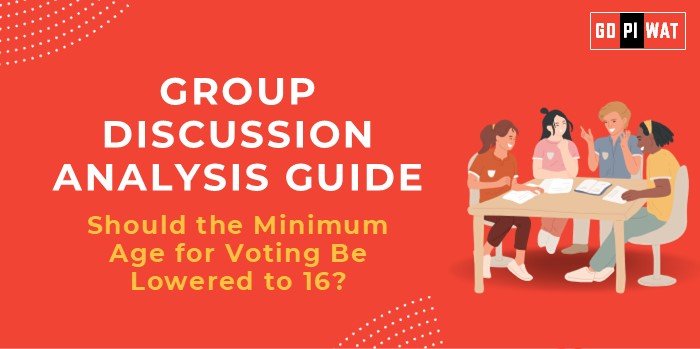📋 Group Discussion Analysis Guide: Should the Minimum Age for Voting Be Lowered to 16?
🌐 Introduction to the Topic
- 📖 Context Setting: Globally, debates around the voting age touch on themes of youth empowerment, democratic inclusivity, and civic responsibility. India, a youthful democracy, has over 50% of its population below the age of 25, making this topic highly relevant.
- 🌍 Topic Background: The global precedent for voting at 18 was established post-World War II, reflecting an era when adulthood was broadly defined. However, changing socio-political landscapes and the evolving maturity of younger generations have reignited debates on this threshold. Notably, countries like Austria and Brazil already allow voting at 16.
📊 Quick Facts and Key Statistics
- 👩🎓 Youth Population in India: Over 356 million individuals aged 10-24, the largest globally, emphasizing their potential electoral influence.
- 🌎 Global Voting Age Trends: 16-year-olds can vote in Austria, Brazil, and Scotland, showing successful integration of younger voters.
- 📚 Educational Penetration: 97% school enrollment at the primary level (UNESCO, 2023), signifying a more informed youth.
- 💻 Digital Natives: 75% of Indian teenagers are active on digital platforms, shaping their awareness of socio-political issues.
🤝 Stakeholders and Their Roles
- 🏛️ Government: Legislative changes and voter education programs.
- 👩💻 Youth: Key beneficiaries and agents of participatory democracy.
- ⚖️ Election Commission: Infrastructure and process adaptation for younger voters.
- 📢 Civil Society: Advocacy for youth representation and readiness campaigns.
🏆 Achievements and Challenges
✨ Achievements:
- ✅ Youth engagement: Participation in civic activities and social media advocacy, showcasing political awareness.
- 📊 Global Evidence: Countries like Austria indicate no decline in voting maturity at 16.
- 📈 Lifelong Participation: Lower voting age increases lifelong voter engagement.
⚠️ Challenges:
- ❓ Cognitive and Emotional Readiness: Questions on the maturity of 16-year-olds.
- ⚠️ Risk of Manipulation: Increased voter influence due to limited life experience.
- 💵 Implementation Costs: Systemic readiness for younger voters.
🌏 Global Comparisons:
- 🇦🇹 Austria: Strong youth turnout post-age reduction, paired with civic education reforms.
- 🇧🇷 Brazil: Voting at 16 is optional, fostering gradual electoral participation.
📄 India’s historical reduction from 21 to 18 years in 1988 saw robust youth turnout, validating the shift.
💡 Structured Arguments for Discussion
- 📢 Supporting Stance: “Lowering the voting age to 16 empowers a politically aware generation and enhances democratic inclusivity.”
- ❌ Opposing Stance: “At 16, individuals lack the necessary maturity to make informed political decisions, risking electoral manipulation.”
- ⚖️ Balanced Perspective: “While 16-year-olds show growing awareness, a phased approach, complemented by civic education, is vital.”
📌 Effective Discussion Approaches
🎯 Opening Approaches:
- 📊 “With over 356 million young individuals, empowering the next generation is key to India’s democratic strength.”
- 🌍 “Countries like Austria and Scotland show that lowering the voting age can foster youth participation in democracy.”
🔄 Counter-Argument Handling:
- ❓ Challenge: “Aren’t 16-year-olds too young to vote?”
- 💡 Rebuttal: “Research shows they exhibit similar political maturity as older first-time voters when paired with civic education.”
📚 Strategic Analysis of Strengths and Weaknesses
- 💪 Strengths:
- ✅ Builds a habit of voting early.
- 📱 Harnesses the energy of an informed, digital-savvy youth.
- ❌ Weaknesses:
- ⚠️ Potential susceptibility to influence.
- 📉 Risk of lower voter turnout due to perceived irrelevance.
- ✨ Opportunities:
- 🔍 Integration of youth in decision-making.
- 📖 Expansion of voter education programs.
- ⚠️ Threats:
- 📢 Pushback from older generations.
- ⚙️ Systemic challenges in implementation.
🎓 Connecting with B-School Applications
🌐 Real-World Applications:
- 📊 Projects on voter behavior analysis, policy implementation, and youth leadership.
❓ Sample Interview Questions:
- ❓ “What could be the socio-political impacts of lowering the voting age in India?”
- 💡 “How can education systems prepare younger voters for elections?”
📈 Insights for B-School Students:
- 🤔 Youth voter inclusion offers opportunities to explore public policy, governance models, and leadership strategies.


